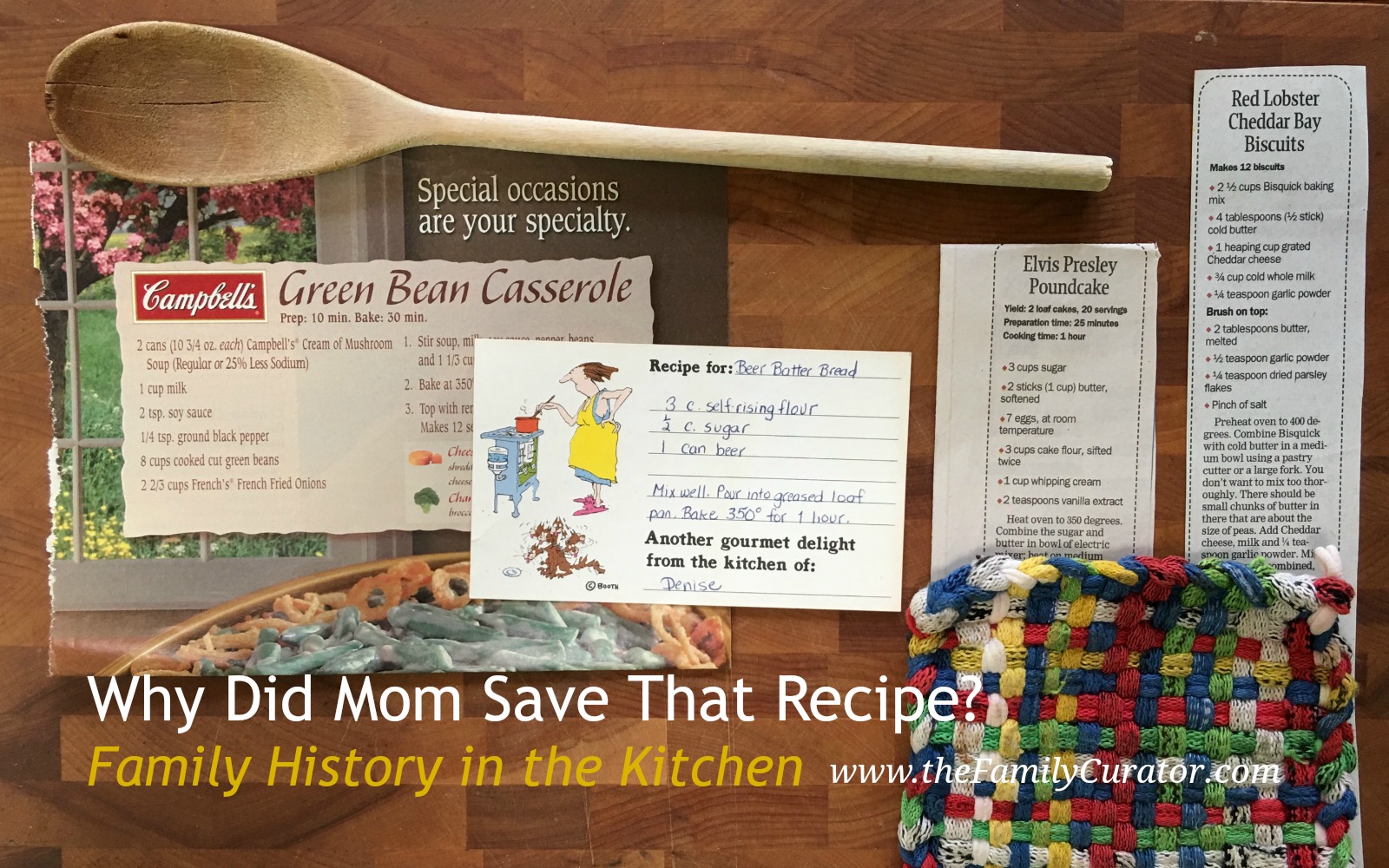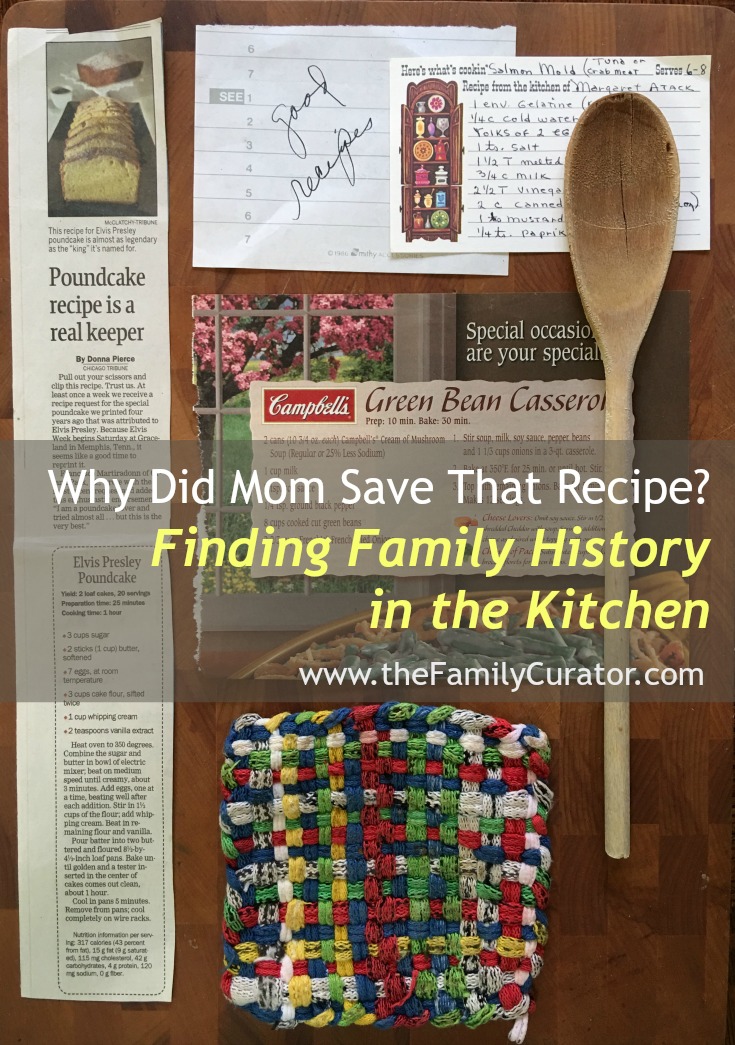Everyone has to eat, so it’s not surprising that favorite family recipes and cookbooks are one of the most popular heirlooms handed down to the next generation.
Of course you’ll want to preserve your grandmother’s handwritten recipe for apple pie, but what should you do with the tattered newspaper clippings, outdated magazine articles, and internet food printouts you found in stuffed in the kitchen drawer? Save or toss?
Like most things found in a family collection, it’s a good idea to pause and peruse before throwing things in the nearest trash can. If you inherited a relative’s recipe collection, don’t overlook a brief tour of what he or she cooked, and dreamed of cooking.
Recipe collections, like a bulging bookcase, can reveal a cook’s personality.
Like many homemakers, my mom Suzanne and her sister Frances snipped and saved recipes to “make someday.” I recently looked through their collections, wondering if they had developed a 21st century craving for Braised Kale Souffle or Green Smoothies. (Hint: they had not.)
Get the Big Picture
Both Mom and Auntie were born in Kansas and moved to Southern California as toddlers, but they never really abandoned their midwest food ways. The recipes they saved reflected their food preferences and the foods my grandmother prepared. Auntie favored Jell-O salad recipes and Mom loved sharing potluck casseroles. The only “foreign” fare in their recipe collections featured ingredients like canned green chilies and cream of chicken soup for Mexican Chicken Enchiladas.
Unlike our neighbors who proudly cooked the foods of their recent Irish Catholic or Amenian-American immigrant ancestors, ethnic recipes were not part of Mom’s family meal planing. There were no unpronounceable ingredients in our Fridgaire or pantry.
When I write a family history sketch, I can say with confidence that sisters Suzanne and Frances embraced cooking familiar American dishes using 20th century prepared convenience foods. Both women leaned to cook in the 1940’s high school Home Economics classroom where the concept of healthy eating focused on modern appliances and readily-available grocery store foods. It’s not surprising then, that our home dinners were mostly simple, meat-and-potatoes meals.
The lack of ethnic dishes makes sense when I recall that our immigrant ancestors arrived in America more than two centuries ago. The practical need for casserole and potluck recipes is explained by a tradition of community church gatherings.
Recipe collections can reveal a family’s food preferences, a cook’s aspirations for culinary adventure, or a firm foundation in cultural or local food ways.
Things to Think About
- Where did the cook grow up?
- How did she (or he) learn to cook?
- What regional foods were a part of family meals?
- What ethic foods were important?
- Did church, club, or community events involve food?
- What holiday meals or dishes were traditional?
- Do you recall any firm food dislikes?
Preserve Favorites
Think about your ancestor cook and the meals you may have enjoyed together. It’s likely you remember a few favorite dishes, and a few stories about the meal or its preparation. Find those recipes if you can, or try to write down what you can remember about how the dish was made.
DIGITIZE
Preserve original handwritten recipes by scanning at 300 dpi and printing a copy for kitchen use.
Recipes are often written on scraps of paper, old envelopes, or whatever might by handy. The paper is typically poor quality, so it’s especially important to digitize the original and cook from a copy.
Scan a photo of the cook, a family meal, or the home kitchen if you find them with your old family photos.
Preserve family recipes by digitizing. #familyhistory #genealogy #foodhistoryClick To TweetPRESERVE
To store your original keepsake recipe, insert the recipe card or paper inside an acid-free folder or archival plastic sleeve. Place the protected recipes in a drop front box or upright document case for protection from dust and light. The Gaylord Family Archives Document Preservation Kit includes acid-free folders and box with gloves and more.
A regular three-ring binder housed on your kitchen shelf is convenient, but will not fully protect the old paper and ink from further deterioration.
Find true acid-free archival storage containers made by Gaylord Archival at www.Gaylord.com or Amazon.
SHARE
Don’t keep those family favorites to yourself! Share a collection of recipes by creating your own family cookbook using scanned images uploaded to a online photo book service like Shutterfly.com or Mixbook.com. Add photos of the cook or your own digital images or your version of the dish.
See the examples and step-by-step instructions for creating your own reproduction book and heirloom photo books in How to Archive Family Photos: A Step-by-Step Guide to Organize and Share Your Photos Digitally, with 25 Easy Keepsake Projects.
Don’t toss those old recipe clippings out with the garbage until you take time to examine and reflect on your relative’s everyday life in the kitchen.
Like this post? Share on Pinterest!








this has been shared with https://www.facebook.com/7TownhomeofMAGRC/?ref=settings&qsefr=1
Thanks for sharing!
I have included your blog in INTERESTING BLOGS or GENERAL INTEREST in FRIDAY FOSSICKING at
http://thatmomentintime-crissouli.blogspot.com.au/2017/03/friday-fossicking-24th-february-2017.html
Thank you, Chris